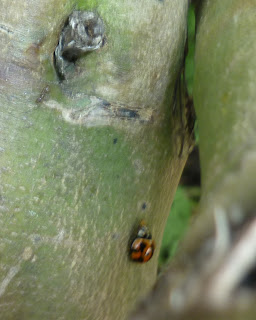So, briefly, this is what is happening:
1. The monarch butterfly lays eggs.
DANGER! DANGER! Wasps eat the eggs, ants carry the eggs away.
 A caterpillar egg, on the underside of a leaf. Why do you think butterflies lay their eggs here?Un huevo
A caterpillar egg, on the underside of a leaf. Why do you think butterflies lay their eggs here?Un huevo DANGER! DANGER! Wasps eat the larvae (Check out this photo)
3. Larvae grow into caterpillars who eat and eat and eat milkweed (swan plants)
DANGER! DANGER! Praying mantises and shield bugs eat caterpillars.
 Caterpillars hanging out together.
Caterpillars hanging out together.Las orugas
 How can you tell one end of a caterpillar from the other?Una oruga.
How can you tell one end of a caterpillar from the other?Una oruga. 
5. Fully grown adult butterfly emerges.
 A newly emerged adult butterfly. The chrysalis was on an orange tree. What can you tell about the colour of a newly-emerged butterfly? Una mariposa.
A newly emerged adult butterfly. The chrysalis was on an orange tree. What can you tell about the colour of a newly-emerged butterfly? Una mariposa. One of the reasons why it took so long for our caterpillars to show up could be because of the pests
We have definitely had wasps around our garden but we haven't actually seen them eating caterpillars yet. Something to look out for...
We also have a never-ending supply of ants at school, and on the swan plant, so this could also be a reason for the slow arrival of caterpillars this year.
However, one of the most interesting interesting problems facing the caterpillars are aphids - and they don't even eat the caterpillars!
Aphids feed on the sap of the plant and pass on viruses which affect the health of the plant - and therefore the food supply for the caterpillars.
But then, (and this is the really interesting part), the ants defend these aphids and 'farm' them by collecting a honey dew they secrete.

But the good news is that lady birds attack and eat aphids. One lady bird can eat about 600 aphids in its lifetime! So, look after the lady bugs - they are helping keep plants safe from aphids.

Check this site for more information about the monarch butterfly in New Zealand.
Today, in Spanish classes, we decided to change what we usually do and learned about the life cycle of the butterfly, in Spanish, instead. We went outside to our class garden and counted chrysalids and caterpillars - in Spanish.
¿Dónde están las orugas?
Aquí están las orugas.
el huevo = the egg
los huevos = the eggs
la oruga = the caterpillar
las orugas = the caterpillars
la crysálida = the chrysalis
las crysálidas = the chrysalids
la mariposa = the butterfly
las mariposas = the butterflies
la hormiga = the ant
las hormigas = the ants
el áfido = the aphid
los áfidos = the aphids
 One caterpillar decides to make its chrysalis under a geranium leaf. I wonder why.
One caterpillar decides to make its chrysalis under a geranium leaf. I wonder why. 




No comments:
Post a Comment